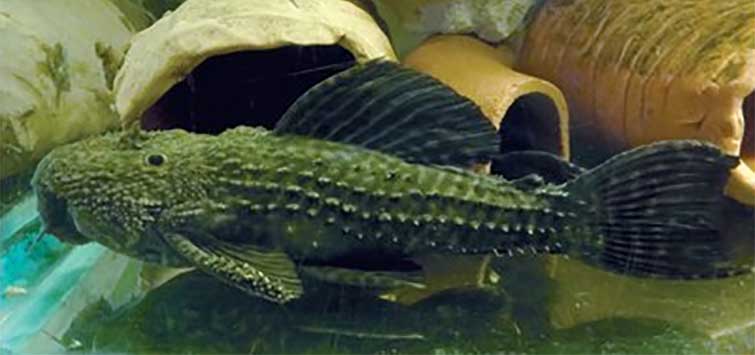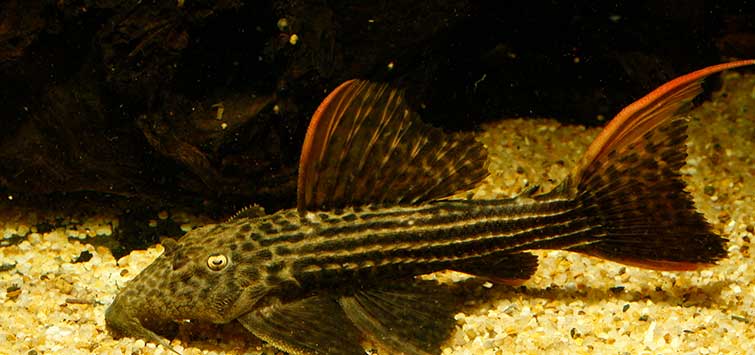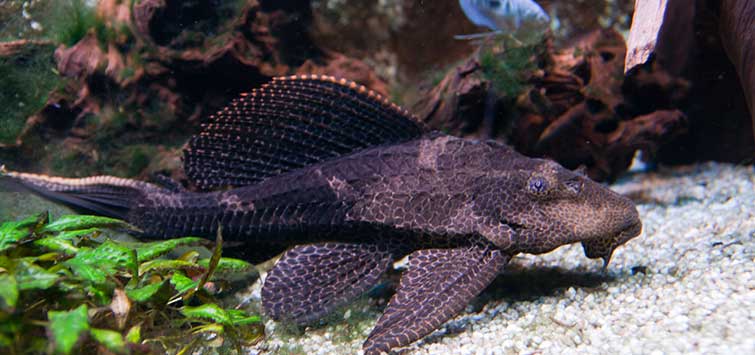The Blizzard Cactus Cat: Spawning a Spectacular Pleco
Author: Andrew White
Several years ago I purchased some juvenile blizzard cactus cats, also known as L065. These were young loricariids, about 1½ inches (4 cm) in length, and were so nice-looking that I immediately called and ordered some more, eventually receiving a total of eight fish.
The Stunning Blizzard Cactus
I had always liked the looks of this pleco. I first saw one in the book, Aqualog: Loricariidae—All L-Numbers (Hollywood Import & Export, Inc., 2004), which had a tempting (if not especially revealing) photograph. More intriguing were the other two mysterious pictures provided, which weren’t photos at all but pencil drawings. What was this elusive fish that looked great in one picture, but was so rare or hard-to-photograph that they had to sketch it? Even the drawings were great!
This was a solid black fish with large, irregularly shaped white blotches. It was just fantastic! I struggled to find any other actual photos of this fish. I then stumbled across a website that had some spectacular pictures of this pleco, referring to them as cactus cats, blizzard cats, mustang blizzard cats, or even blizzard cactus cats. The ones I received were not quite as amazing as those pictured on the website, but they were close, and I had somehow been lucky enough to acquire a young group.
These fish resemble plecos from the genus Pseudacanthicus, but are called L065 as they have not yet been scientifically described. They are similar in appearance to other L-number catfishes like L097, L282 and L380. It is possible that these four different L numbers are actually a single species and that their slight differences in coloration are simply variations found from different populations. They are all basically black- or charcoal-colored spiny fish with variable amounts of white spots.
A Single Egg
After acquiring a group of young blizzard cactus cats, I placed them into a 58-gallon (220-liter) tank, where they stayed for a few years as they grew. They ate well and grew fast—some remarkably so—and I moved the entire group into a 110-gallon (415-liter) tank. They were fairly tolerant of each other, for plecos, and were surprisingly active, even during the day.
Dominant Males
Two larger males were clearly dominant, achieving a length of about 10 inches (25 cm), with an impressively bulky head and generous spines on the side of the body. The term “beast” is perhaps the best descriptor of a full-grown male!
Remaining Specimens
The others stayed smaller, anywhere from 5 to 7 inches (12 to 18 cm), and I did not think sexing them was too difficult. In addition to the two large males, I thought I had at least one female, who was rounded in the abdomen and had a smaller, narrow head. The others were trickier to tell apart; their heads were not as thick and wide as the big, dominant males, and they had rounded abdomens like the female, only not as pronounced. Indeed, they were all well-fed and husky in appearance. Most had completely lost their white spots, becoming a dark charcoal gray, like a clean chalkboard. A few had kept them, although the spots had grown smaller, more numerous, and less distinct. Some of the fish were impressively spiny, while others were less so.
One Female
Based on their wide heads, rounded abdomens, and general spiny features, I finally concluded I had only one female among seven males. I was about to give up hope of a spawn when I saw a single egg outside of a large cave. There were no other fish in this tank, so they must have spawned. I was ecstatic and even emailed Julian Dignal, a loricariid expert, which probably jinxed my success.
Hope and Loss
The male stayed in the cave with the eggs (or fry—I was unable to get a look into the cave, as it was oriented parallel to the front of the tank) for about a week, and I remained hopeful. Then, one morning, I was disappointed to find that the father had abandoned the cave. I found no further evidence of either babies or eggs. Worse still, two years went by without any other signs of a second spawning.
I figured there must have been too many males in the tank, and that the female might not have been getting enough food to produce another mass of eggs. So, I took out three of the sub-dominant males, leaving the two largest ones in with the female (I wasn’t sure which one she had spawned with previously). I also kept a small male in the tank for them all to chase and bully. I put the three extra males in a 75-gallon (284-liter) tank. One fish remained unaccounted for; I seemed to have lost it at some point.
As Time Goes By
The three males in the 75-gallon (284-liter) tank did well. One clearly became more dominant, grew a bit larger than the other two, and became much more bristly. The other two were essentially indistinguishable. The tank was equipped with two large canister filters and a heater, keeping the water between 80° and 82°F (27° to 28°C). It had a trivial layer of gravel, a large piece of driftwood, some live plants, and several rocks and clay caves.
What I now believed were two definite pairs remained in the 110-gallon (415-liter) tank, with lots of rock, some wood and ample cavework (also cleaned by two canisters) but heated to 86°F (30°C). I used only tap water, without any reverse osmosis or rainwater additions.
Fighting for Attention
The female got larger and fatter and the two big males would display for her, fight over her, and attempt to lure her into their caves. There was occasional minor damage from fighting, evident from the amount of black color that they scraped off each other, which revealed white skin underneath.
Feeding
I fed them primarily meaty sinking pellets, but these plecos also loved eating shrimp. Once a month or so, I would buy small ones with the shell on from the grocery store and the catfish would devour them. One or two a night would be eaten with only remnants of shell visible in the morning. The three extra males in the 75-gallon (284-liter) tank just got pellets. I chose to not offer them shrimp.
Water Changes
I started increasing the frequency of water changes in the 110-gallon (415-liter) tank, determined to repeat the failed spawn. Changing ⅓ of the water twice weekly made the tank look pretty and clean, and the female more egg-laden, but still no luck with another spawn. I added a timer to the heater to help the tank cool off at night, hopefully simulating any natural temperature variation in their native habitat.
A Lesson in Anatomy
Then one day I noticed the persistent occupation of one of the caves in the 75-gallon (284-liter) tank, not the 110-gallon (415-liter)! A sub-dominant male seemed to be sitting in the cave, positioned exactly in the middle, in the typical pose of a male pleco who was guarding eggs. I love this position! It was dead center, with occasional alternate waving of the fins. This is always a sign of a spawning, and once you recognize this pose, you won’t forget it. He had been in his cave for days. My L065 did not usually occupy caves for any period of time, preferring to be under ledges or the edges of rocks.
I ignored this male for several days, figuring there was no chance of spawn in an all-male tank, until I got out a flashlight to check on another group of fish in a different tank. On a whim, I shined a light in the cave and saw well-developed wrigglers. I immediately looked at the other two fish. The biggest dominant male looked hungry, and was hoping I was about to drop in some pellets, while the other fish still looked male to me—and slim. I checked the tank thoroughly with the flashlight. There were no other L065s in here, just a small pair of L199, a tenth the size of the big plecos.
I rechecked all the tank parameters. The temperature was 81°F (27°C), with filters running, and the water level kept low at about 4 inches (10 cm) from the top, with lots of aeration and current from the filters.
Found Female?
Could this possibly be a female, and could this be the first known female guarding eggs? Or were these eggs from the small pair of L199 that the L065 kidnapped and was raising as his own? I had a big decision to make—should I try and get the wrigglers out, or leave them in with the parents? Should I give them another week? I set up a 10-gallon (38-liter) rearing tank and decided to leave them in the cave with their unsexed parent while I waited patiently. I then went searching for some pictures I had taken of these three “males” when I had them in a bucket, prior to adding them to the 75-gallon (284-liter) tank, and set about reassessing my skills at sexing.
I finally found the old pictures, and upon closer review discovered that my sexing skills were clearly inadequate. The three males were actually two males and one female. The key difference is visible in a photo taken from directly above, in which the head shape of the female is narrow and more angular (a smaller, more acute angle), less well-rounded, and less bristly than the males.
Arrival of Fry
The waiting issue was solved when my brother made an unexpected visit and wanted to see the babies. I grabbed a very large, shallow plastic bowl, added some water from the tank, and picked up the breeding cave to try and pour out some of the fry. I was shocked when the dad quickly abandoned the cave as I poured out the contents, joining the many babies in the bowl, thus immediately endangering their lives from crushing. I quickly picked him up bare-handed, and—despite his frantic wriggling and sharp spines—put him immediately back in the tank, ignoring my now-bloody hand.
Most of the babies were in the bowl, so I immediately put the cave back in the tank, even though there were a few babies left in it. The father was nowhere to be seen. I had about 75 wrigglers in the bowl now—plenty to try and rear myself. I transferred them to a small hang-in-tank plastic specimen container that I had adapted by adding a piece of screen to allow better water exchange with the tank. A tiny piece of very seasoned driftwood, which I had simply ripped off a larger section of wood, was added to the container, and this was placed in the tank in front of the outflow of a filter.
Incidentally, the next morning the dad was back in the cave with the remaining babies, which had stayed in there as well. He continued to protect these fry until they left the cave on their own.
The babies in the container still had some yolk sac remaining; this was absorbed in about two days. I started feeding them by dropping in a sinking pellet, which they chewed on heartily. They grew very quickly, and the babies would finish two pellets each night. In two weeks, they had doubled in size to about ½ inch (1.5 cm). They were also much darker, and their white blotches were becoming nicely visible. They continued to grow quickly, and became stocky and playful.
In the Community Tank
When I added them to a community grow-out tank with various other young plecos and guppies, they would chase other young plecos from their territories and food pellets, and they swam with a side-to-side wobbling motion, almost like tadpoles. They tolerated water changes without difficulty and accepted a variety of sinking pellets. I also occasionally added freshly crushed snails, which they seem to like, and which are a great use for my excess Malaysian trumpet snails. However, their favorite food seemed to be shrimp. I cut off a grape-sized piece from a frozen shrimp in my freezer, anchored it with a metal skewer, and placed it in the corner of the tank where I knew they liked to hide. Usually, the piece of shrimp was gone in a day.
Updated Spawns
I have now had several spawns from this same group of three (supposed) males. I removed the larger dominant male, and left only the actual spawning pair in the 75-gallon (284-liter). They continue to grow, and are now about 7 inches (18 cm) in length.
The second spawn was complicated by fungus and I lost many eggs. I suspect there may have been incomplete fertilization, which led to the fungus attack. As the adults have grown, the spawning cave became too small for the pair to fit in easily. When the female was in, the male could only get about half of his body in behind her; presumably, he was not in far enough when he released his milt.
For the third spawn, I removed the smaller clay cave, replacing it with a longer cave. The third spawn was much more successful and had an apparently 100-percent fertilization rate. Nearly 100 fry are currently growing out to be distributed to the tropical fish community. I have had no luck, however, with the original obvious pair of fish in the 110-gallon (415-liter) tank, despite the female being clearly ripe with eggs. My fingers are crossed.
Blizzard’s Bright Future
The blizzard cactus cat, or L065, an undescribed Pseudacanthicus-like species, is a gorgeous loricariid. The young are black with large blotches of high contrast white, and the adults are slate gray with giant spines. This fish is well-suited for the home aquarium. Its calm temperament, relatively small adult size, active daytime swimming, and successful captive reproduction should make it popular with tropical fish hobbyists for years to come.

.png?h=595&iar=0&w=2781&hash=5FD5E69473BCC22199FBFA2FB71B6033)



